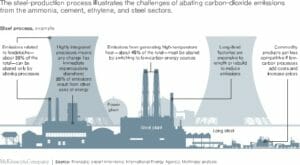Written by Karen Spiegel
Reducing greenhouse gas (GHG) emissions is critical to preventing the dangers of climate change, particularly in the industrial sector which accounts for 33% of the anthropogenic emissions. Climate experts suggest that blockchain technology could play a significant role in creating a system of standardization and accountability by accessing the carbon footprint of companies and tracking the offsets. The crux of the issue is settling on a structure for calculating those metrics.
Historically, being able to validate proof of impact has been a challenge. Part of the issue is that the criteria has changed over time.
Typically generating carbon footprints and eventually the offsets require manual meter readings to determine energy consumption, emissions and calculating carbon footprint. This is time consuming and there are many opportunities for data to be unreliable and inaccurate.
It is especially problematic in certain industries such as the hard-to-decarbonize sectors including aviation, shipping, trucking, cement manufacturing and steelmaking. Other issues add to the complexity. Sustainability certifications/schemes such as Guarantees of Origin (GO) system allow fuel to be sold as renewable to consumers, but GO certificates have a slight impact on renewable energy generation and don’t provide evidence of renewable energy capacity. This image illustrates some of the difficulty in removing CO2 emissions from the steel industry.
A key driver to achieve accountability across ecosystems is to push for digitization at a system level. This will increase efficiency by moving away from manual data collection and could enhance the management of energy systems and other industrial networks with complex transactions. Greater investment in digitization technologies, particularly for aviation and heavy transport, along with electrification of the industrial processes that align with policy, is essential.
But what if blockchain could be utilized to determine the carbon footprint and then ultimately be aligned with carbon offsets? This yields real numbers encouraging organizations to refrain from overpromising and underdelivering on emissions reductions since the results could be monitored without the cumbersome manual data requirements. It also permits greater confidence in the metrics encouraging increased financial investment in underlying low-carbon or zero-carbon technology solutions. Beyond this there are tangible benefits such as creating full transparency and traceability within the supply chain, decentralized and sustainable resource management, unlocking new capital, incentivizing a circular economy, transforming the carbon market through the use of cryptographic tokens and creating greater confidence for investors in sustainability reporting, monitoring and verification.
There are numerous organizations developing such ecosystems such as Climate Chain Coalition. It is a global initiative among members to collaborate on the advancement of blockchain and other digital technology to mobilize financing of climate solutions and enhance measurement, reporting and verification of climate actions at scale. Another is Blockchain for Climate, which tags information associated with each credit in order to validate the authenticity of carbon credits. The system tracks and traces along with verifying transactions. And the system can easily scale which is critical due to the volume of transactions.
Other companies are creating blockchain opportunities in the transportation sector. Last year in Singapore, CarbonAir Exchange launched the world’s first global blockchain-based carbon exchange. For companies in the transportation sector, it provides EEU’s (eligible emission units) to secure carbon dioxide (CO2) offsets. The carbon credits will be securitized by tokens and utilize blockchain technology. Manufacturers in the auto sector, such as Mercedes, are teaming up with Circulor to trace carbon emissions in the cobalt supply chain. This will eventually include climate-relevant gases and the amount of recycled materials along the complex supply chains of battery cell manufacturers. Mercedes intends to utilize the data to inform development of its carbon-neutral passenger fleet. Companies in the cement industry, another sector that accounts for approximately 8% of global CO2 emissions, are teaming up with universities to generate innovative solutions to develop and commercialize low carbon concrete.
An array of startup companies, both private and public, are also creating blockchain solutions to encourage additional investment in the energy sector from infrastructure to incentivizing renewable investment.
This is just the beginning. Whether it is tracing and tracking supply chain or the development of robust carbon trading architecture such as the one created at Arizona State University . There is a tremendous amount of momentum toward developing innovative technologies that embrace blockchain in the energy sector, but specifically in industries that produce significant CO2 emissions. Blockchain is becoming an increasingly more useful tool in the decarbonization tool chest. Providing an immutable, secure, trustworthy, and scalable solution to a decarbonized future.


